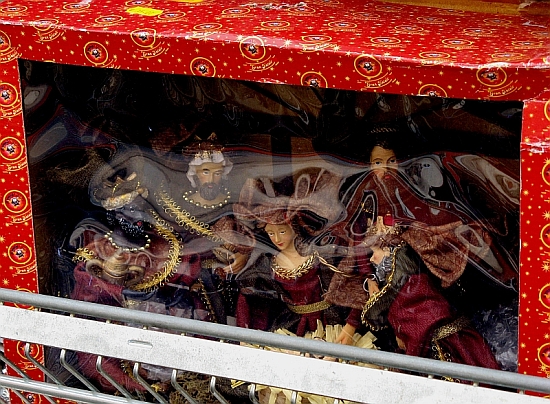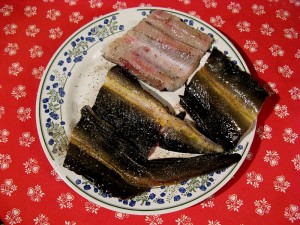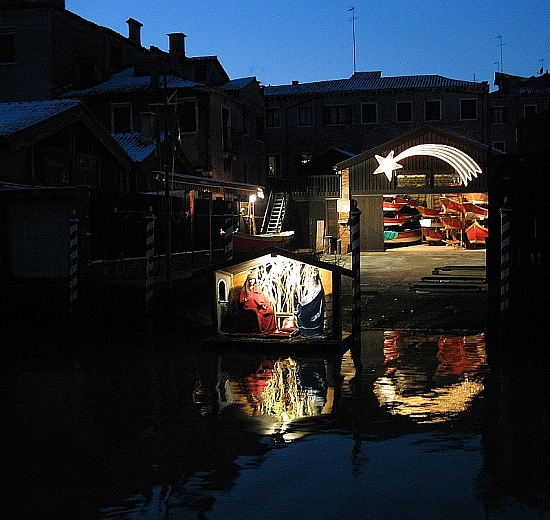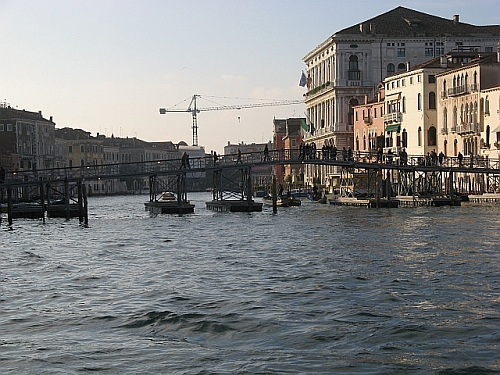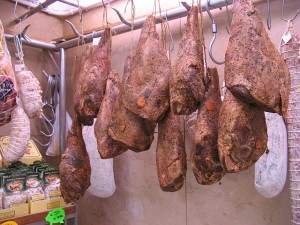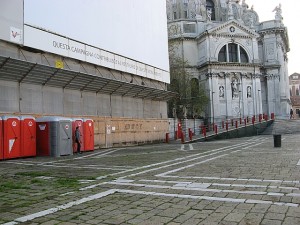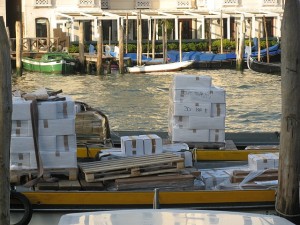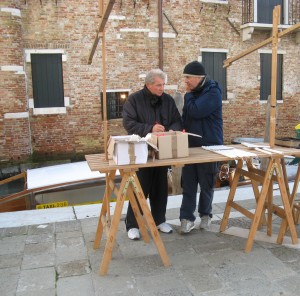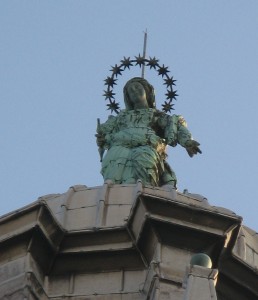A situation has been brought to light — actually, had light suddenly and dramatically shone on it — that ought to be noticed more clearly than by the faint gleam discernible over here. Allow me to step in with at least a couple of highway flares.
A few paragraphs in the Gazzettino recently revealed that the basilica of Santa Maria Assunta at Torcello is falling apart. Brief and brutal, but there it is. This news may not have interested very many people here because the paper is full of stories, depressingly often, about the ways in which Venice is falling apart.

Pieces of stone drop off facades (November, 2007, a 110-pound/50- kilo chunk fell from the Palazzo Ducale and grazed an elderly German tourist; November, 2008, a 15-inch/40 cm bit of marble from a house in the San Marco area grazed a Swiss tourist as it headed earthward; March, 2010, a 132-pound/60-kilo piece broke off the convent of Cristo Re near the Celestia; October, 2010, a bit of stone decoration fell off the Court building and struck an employee…..). Roofs collapse, bell-towers are braced, and so on. The reason? All together now: No ghe xe schei. The mayor himself has said that he may have to ask for money, not for the sake of the buildings per se, but for the sake of public safety.
But back to Torcello, a lovely, almost uninhabited little island famous for the aforementioned basilica, which is arguably one of the gemmiest of the gems of Venetian history, art, architecture, and above all, mosaics.
Life is hard on Venice in so many ways, from high water to tourist trampling. But let us not overlook what may be the most dangerous hazard of all: Neglect.
Torcello’s parish priest, don Ettore Fornezza, recently drew attention to one example of what neglect can lead to: The floor mosaics are breaking up.
I went to Torcello the other day to see don Ettore and the situation that he was describing.
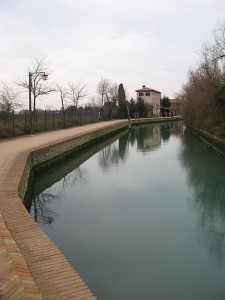
For anybody who loves Torcello, or who believes that there is no place within 50 miles where you can go to escape the tourist tidal waves, I cheerfully recommend you visit the island early on a freezing, windy, gray Sunday morning in January. Yes, it was colder than I don’t know what. (Down side.) But there was literally no one and nothing in sight. (Up side!) I’ve been going to Torcello for years and I have never seen it utterly deserted. The lagoon was empty too. It was so astonishing that it was worth not being able to feel my feet.

People go to Torcello to admire the mosaics on the walls. But the floors are no less valuable, and they get a lot more punishment. You can see the evidence of this deterioration everywhere, in the widening spaces between the bits of stone and even in grotty, dark empty areas as big as salad plates and as much as an inch deep. Unchecked humidity, for one thing, has gradually loosened the tesserae (as the bits of stone are called) and made them vulnerable to other forces. Like people and their footwear.
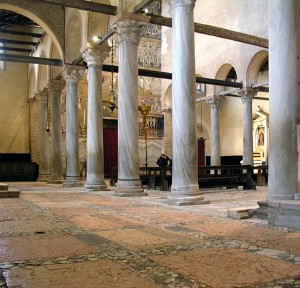
And so it was that during a recent stroll around the church, don Ettore saw a tourist not only dislodge a small piece of 1000-year-old mosaic with the heel of her shoe (regrettable but not intentional), she then picked up the loose bit and made to put it in her pocket. Or purse. Anyway, to take it away.
When he asked her what she was doing, she replied, “I wanted it as a souvenir.”
Somewhat thunderstruck, he suggested she consider leaving it behind, so it could be kept, if not actually returned to its native habitat.
She gave it back.
When don Ettore reached this point in the story, it occurred to me that it was too bad he hadn’t replied, “Well then, I’d like to take your shoe as a souvenir.” Just a thought.
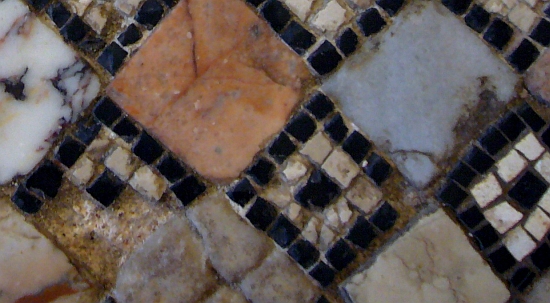
But this is no time for gay repartee. The incident of the tessera was merely one random event in a long and all-too-evident decline. Because for some time now, the heels of the shoes of thousands of tourists a day have been weakening what is, in fact, a very fragile creation. All it takes is for one piece to go, and the discussion shifts from what is happening to merely how long it’s going to continue.
For don Ettore, this moment was, as he put it, “the spark” to bring to light the larger, deeper, wider problems of the basilica.
“We can’t go on like this,” he said. “People come from all over the world, and they see the deterioration and they come to tell me. I can’t do anything, because I”m responsible for the spiritual side. But I have eyes, and I see the things that don’t go well. Torcello could be reborn, with a little attention. With the love people have for this place, this would be the pearl, not only of Venice, but of the world. It’s worth the trouble to insist on this, because Torcello is worth it. We don’t want Torcello to die. If it were up to me, it would have been resolved already.”
There are so many distressing aspects to this situation that you can pick any one at random and ruin your day. Given that the present mosaics (not the first mosaic flooring, by the way, which was laid in the 8th century) date from 1008, it’s obvious that they will now be in need of constant and expensive care. Just like a person, actually, when you think of it.
But here we have an ancient and irreplaceable work of religious, historic, and artistic value; we have uncontrolled masses of people using it every day for most of the year; and we also have lack of personnel, lack of serious interest, and — no need to repeat it, but I must — absence (they say “lack”) of money to do anything useful to deal with it. Here, too, the skeletal hand of chronic poverty is tightening its grip.
Speaking of poverty, however, let me insert some startling observations made to me in Hyderabad, India by Mr. P.K. Mohanty, then Commissioner of the city’s governing body. (I was there for my article on “Megacities,” National Geographic, November 2002.)
“What we need in India isn’t money,” Mohanty said. “Large cities of the Third World are reservoirs of wealth. We need political reforms, bureaucratic reforms. The problem is one of poor management. If cities are properly managed, there cannot be resource problems.” I’d guess that the same could be said of large cities of the First World.
As for the mosaic floor of the basilica, nobody can consider spending the money that would be needed to complete a serious restoration — they say there’s no money even to pay for a protective carpet like the one that often covers the floor of the basilica of San Marco. But anyone who has visited the Roman-mosaic-blessed former churches at Aquileia and Ravenna will recall that their mosaic pavements are kept in near-perfect condition. Aquileia and Ravenna have mysteriously found a way to acquire the schei necessary for their mosaic maintenance. Or maybe, as Mr. Mohanty observed, the problem isn’t really schei.
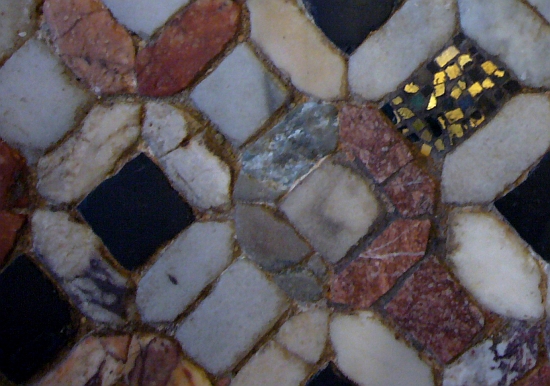
Back to Torcello. I would like to blame mass tourism, because obviously masses of tourists are not helping the situation. But I hesitate to use a term which is so general that it could describe almost everything except plants (no wait, those travel too) to describe just one certain type of tourist. Of course there are cultivated, intelligent, sensitive tourists who leave a very faint footprint on the delicate, peerless places and cultures they visit.
But there is the clueless tourist who tends to come in chaotic herds, and who passes through leaving behind not much beyond a few sous and a lot of accumulating wear and tear on the places and people he or she has encountered. And some trash, usually.
Taking away pieces of Italian history is nothing new. The Italians themselves, over the centuries, have removed tons of pieces of their monuments for use in other projects. And there are, unfortunately, still too many tomb-robbers who steal and sell priceless artifacts from lost civilizations.
And let us not forget the famous advancing barbarian hordes, who pillaged and burned and wrecked large parts of Europe and its treasures. Also bad, but at least you can fit this damage into the category “Conquer and Dominate,” which does make a kind of sense.
But we’re talking about tourists. They have been known to dislodge and remove, as far as they can, pieces of the Roman walls built by Marcus Aurelius. Tourists climb over altar railings and try to take away historic sacred vessels. (I am not making any of this up.) I learned more than I ever wanted to about this for my article “Italy’s Endangered Art” (National Geographic, August 1999). These are not necessarily evil people, nor even people seeking to make money by selling what they take. They just take. Why?
The lady at Torcello admitted why she did it: She wanted a souvenir. Instead of buying something that had been manufactured, she impulsively felt that something genuine would be better. But how does this work? You take a little piece of old stone, dislodged from its context, dislodged from its reason for being, specifically in order to be reminded of the place you’ve just despoiled? You don’t run to the ticket booth to say “The floor is coming apart!”? Or does the fact that the piece is loose mean that it’s now free pickings?
I pause here to recognize that there may be an insignificant difference between a souvenir and spoils of war; the Elgin Marbles, which I suppose you could regard as a sort of monumental souvenir, come to mind. But if the possessors of cultural patrimony have finally come to recognize at least some of the value of their heritage, it ought to follow that visitors ought to value it even more, otherwise why are they there? They could just as well be sitting under an awning somewhere, eating gelato.
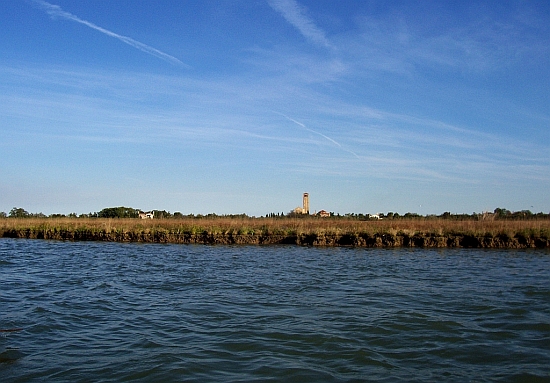
All this makes my brain hurt. Because I am convinced that whatever bits of stone or wood or pottery get carried away — a bit that really mattered where it was born — is going to get lost. Thrown away. Forgotten. Hidden under stuff in the attic that nobody ever looks at until they have to sell the house and by then nobody remembers what the thing is, or why it’s there. So what was the point?
Wait! Let’s say the person takes it home and puts it in a beautiful box or frame to display it. This means that either they are capable of spending the next 50 years looking at something they stole, which probably won’t remind them that they stole it, or they want other people to admire it. So they can say, “Yes — I contributed to the destruction of an irreplaceable landmark by stealing this. Nice, isn’t it? I’m glad you like it.” Then they send money to protect the dolphins or save the rainforest.
If you’re still reading, you may be edging toward the door. But I’m not crazy. Or if I am, I’ll never be as crazy as the tourists.
But let’s be fair. Even if the tourists were all made to tiptoe around the church in cloth slippers, it wouldn’t do much to stave off the inexorable damage caused by humidity, salt in the groundwater, storms, subsidence, and many other factors that are part of life on this planet and whose effects are all too visible at Torcello.
The point isn’t that people want to take bits home, it’s that the church isn’t being protected and cared for. It’s just sitting there, enduring what it must till another piece breaks off.
And by the way, the same thing is happening in the church of Santa Maria e Donato on Murano (first building, 7th century, flooring completed 1140), an edifice equally rich in mosaics. Don Carlo Gusso, the parish priest, is also ringing the alarm bells.
So far, though, it appears that nobody but you and me have heard them. Or at least have recognized that they’re not the dinner bell.
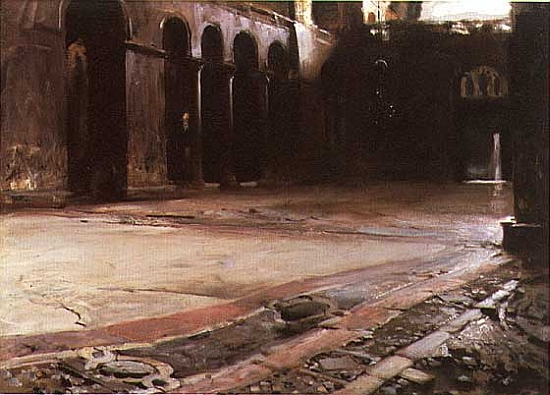



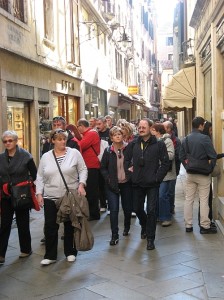
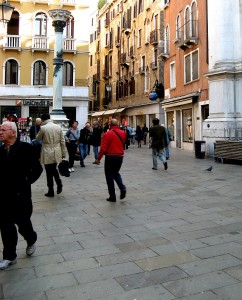

![IMG_1021 lapide There is a fair number of similar plaques around the city -- yes, literally carved in stone -- which remind Venetians of how to behave. This is one of the simpler versions, written in an interesting mix of Venetian and Italian and Latin. "1633 22 June. All games are forbidden, of whatever sort they may be, and also to sell things, set up a shop or corbe [large wicker baskets for carrying coal], to utter blasphemy or other indecencies around this church or any nearby sacred places, and this is by deliberation of the Most Excellent and Serene Executors against Blasphemy with the penalty for transgressors of prison, the galleys, banishment, and also [a fine of] 200 small lire [paid] to the accuser and the captors.](https://iamnotmakingthisup.net/wp-content/uploads/2010/12/IMG_1021-lapide-225x300.jpg)

